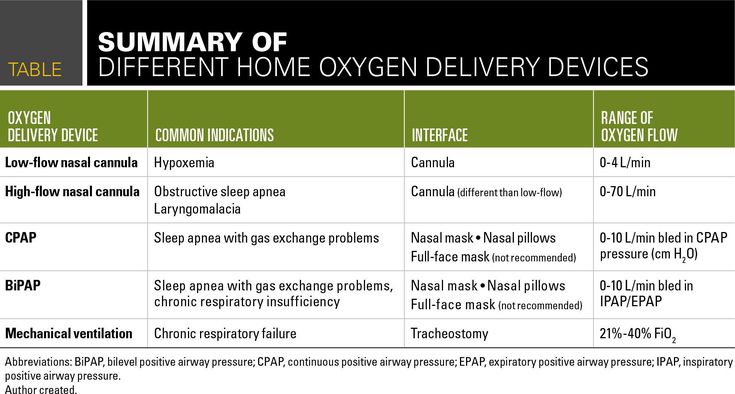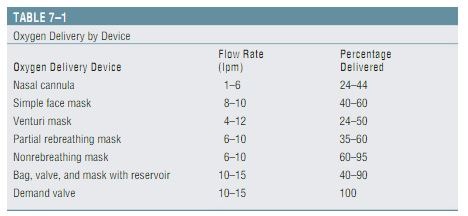How much oxygen does the cannula deliver. Delivery rate of less than 6 LPM.

Nursing Archives Health And Willness
1 Identify regulator and check for grommetwasherring.

. NONREBREATHER MASK - 15 lpm. BURP backwards up right pressure on the cricoid cartilage. Device delivers 24-60 oxygen depending on the adapter tip and oxygen flow rate.
1-6 liters per minute. Bag-mask ventilation BMV device b. Below is an image of the Fisher and Paykel Optiflow nasal cannula junior range for AIRVO 2.
Tube with a mask or nasal cannula. Humidifier Use the following manualmechanical ventilating devices. Oxygen delivery devices 1.
Only goes up to 60 FIo2 so not for patients who have significantly high oxygen demands bulky. When discontinuing oxygen it is better to turn off. Delivery devices work with different flow rates.
Low flow O2 delivery device 05-6 Lmin. High-flow warmed and humidified nasal oxygen For patients who need higher concentrations of oxygen at flow rates of 10-40 liters per minute. Designed to entrain a set amount of O2 and air which combine to produce a set flow of O2 the stated on the venturi.
Or longer Must be clearly labeled as Emergency Oxygen Emergency oxygen is delivered from a cylinder through a pressure regulator and oxygen tubing and into a delivery device such as a mask cannula or bag mask. The percentage of oxygen inspired depends on the flow rate and the delivery device. 200969111 Bailey P Thomsen GE Spuhler VJ et alCrit Care MedJan2007351139145.
Higher flows 4 Lmin make it uncomfortable for the patient. Select appropriate oxygen delivery device The available devices include the non-rebreather mask nasal cannula and the Bag Valve Mask BVM. How much oxygen does the simple face mask deliver.
Requires prescription for use. They include Nasal cannulae. Hudson Nonrebreather Teleflex Medical 1012 80100.
It varies from 0 15L per minute. The flow rate can be set on the wall tap. Low flow device Most common device used for mild hypoxia Can be set between 1 and 6 LPM 24 to 40 FiO2 FiO2 increases approximately 4 with each liter of O2 KorupoluR GJ Needham DMContemporary CriticalCare.
This EMT basic study guide will explore the devices for containing and supplying oxygen in the medical environment. 6 to 10 lpm. FiO2 21-95 - Note the oxygen flow rate from the wall or portable sources should not exceed the flow rate of the Airvo2.
Lpm liters per minute Situation in which an EMT-Basic would use a Nasal Cannula instead of a Nonrebreather Mask. 2 to 15 Lmin. Administer oxygen using delivery devices including but not limited to.
Higher flows 4 Lmin make it uncomfortable for the patient. Lmin 1 Resultant oxygen concentration. Normal oxygen flow rates for Nonrebreather Mask Nasal Cannula Pocket Mask and Bag-Valve-Mask.
1 to 6 lpm. Varied depending on device. When the tap is manually opened the oxygen takes the line of least resistance to the patient via an oxygen delivery device eg.
Nasal cannulae Teleflex Medica 1. How much FiO2 you receive from your oxygen concentrator depends on your flow rate. Delivers 100 O2 no need for squeezing to ventilate.
Flow rate 1-4Lmin 4L will dry the nose 2L is more comfortable. OXYGEN DELIVERY DEVICES Dr. 2 Remove dust or debris.
Also called a demand-valve device. Its PSI and the flow rate LPM. A regulator is attached to the cylinders top and works like a tap allowing the safe adjustment of oxygen flow rate provided in Lmin 1.
Hudson mask Teleflex Medical 56. At least 6 LPM for 15 minutes or longer. Oxygen concentration delivered by Venturi mask.
MORS with an oronasal or intraoral mask demand valve with an intraoral mask and NRB at a flow rate of 15 Lmin-1PtcO2 and nasopharyngeal F I O 2 values were. BAG-VALVE-MASK - 15 lpm. The oxygen delivery infrastructure is crumbling under pressure in Los Angeles and other covid hot spots jeopardizing patients access to precious air and limiting hospital turnover.
Oxygen delivery times D Tank Oxygen delivery times M tank. Oxygen delivery or flow rate is calculated by the number of liters delivered per minute LPM Medical oxygen. 4Open tank check for leaks.
A device used to deliver a specific concentration of oxygen. Continuous positive airway pressure CPAP requires EMS Agency approval. It will also review when oxygen administration is indicated or not indicated as a medical intervention.
High Flow Nasal Prong Therapy HFNP See the HFNP nursing clinical guideline for more information. The device chosen will depend on the patient requirements you found during your Initial Assessment. Mask nonrebreather partial rebreather simple c.
Venturi mask flow rate. Training for rescuers required prescription not required. Up to 15 liters per minute.
The flow rate is how many liters of oxygen per minute your device delivers. Indications of O2 therapy 1. For example patients commonly use a flow rate of 2 liters per minute but the flow rate varies by each patients needs.
Oxygen delivery device Oxygen flow rate. Reservoir cannula As mentioned previously reservoir cannulas improve the efficiency of oxygen delivery saving two to four times the oxygen delivered via continuous flow. 24 to 40 according to slides 24 to 44 according to book What is the flow rate of the simple face mask.
A flow rate of 2 liters per minute increases the FiO2 from 21 percent room air to 28. Can delivery precise and dependable FiO2. These devices deliver a variable inspired oxygen concentration to the patient which depends on the PIFR.
NASAL CANNULA - 6 lpm. Duration of less than 15 minutes. POCKET MASK - 15 lpm.
A pressure reading barometer displays the remaining oxygen. Flow-restricted oxygen-powered ventilation device. Documented hypoxemia In adults children and infants older than 28 days arterial oxygen tension PaO2 of 60 mmHg or arterial oxygen saturation SaO2 of 90 in subjects breathing room air or with PaO2 andor SaO2 below desirable range for specific.
3Correctly assemble tank with regulator closed. Adapters deliver set amounts of FiO2 at 24 to 60. Does not require a prescription Has a delivery rate of at least 6 LPM for 15 min.
When warmed and humidified high flow. Also called the Sellick maneuver. Connect the oxygen tubing to the regulator do not over tighten the tubing to the regulator.
Depending on a patients inspiratory effort tidal volume speed of inspiration and respiratory rate the PIFR can often exceed the flow rate at which oxygen or an oxygenair mixture is supplied by the device meaning that at the time of PIFR. Of the commonly available devices promoted for O 2 delivery to injured divers similar P tc O 2 and nasopharyngeal F I O 2 values were obtained with the three devices tested.

Ems Oxygen Admin Flowchart Flow Chart Oxygen Emt

Patient Assessment 2019 Limmer Education Llc Emt Study Emergency Medical Responder Assessment

Medical School Oxygen Delivery Devices What To Know Emergency Nursing Nursing School Survival Pediatric Nursing

Oxygen Delivery Devices In 5 Min Youtube

Patient Assessment Form Emt Seven Things That Happen When You Are In Patient Assessment Form Emt Study Lpn Schools Nursing School Studying

Oxygen Delivery By Device Nasal Cannula Indicated For Low Flow Low Percentage Sup Respiratory Therapy Student Icu Nursing Respiratory Therapist Student

Oxygen Delivery Devices Chapter 10 Diagram Quizlet

Oxygen Delivery Devices And Strategies For H1n1 Patients Ppt Download

Oxygen Delivery Devices Ppt Video Online Download

Oxygen Delivery Devices What To Know Respiratory Therapy Student Pediatric Patients Respiratory Care

Oxygen Delivery Equipment 1 Respiratory Therapy Student Icu Nursing Respiratory Therapist Student

Oxygen Administration What Is The Best Choice Rt

Oxygen Delivery Devices What To Know Respiratory Therapy Student Pediatric Patients Respiratory Care

Oxygen Delivery Devices Medical Gas Therapy Ch 41 Flashcards Practice Test Quizlet

Upper Airway Assessment And Management Nurse Key In 2021 Icu Nursing Critical Care Nursing Icu Nurse Critical Care

Pin By Carey Allen On Respiratory Therapist Icu Nursing Pharmacology Nursing Emergency Nursing

Chapter 7 Meds Treatment Of Cardiovascular Emergencies Flashcards Quizlet


